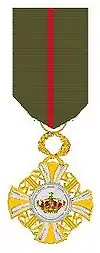Order of the Crown (Monaco)
The Order of the Crown (French: Ordre de la Couronne) is an order established in Monaco on 20 July 1960. This decoration is awarded to people, who have done something exceptional or by their exceptional conduct.[1]
| Order of the Crown Ordre de la Couronne | |
|---|---|
 Knights' cross of the Order of the Crown | |
| Awarded by | |
| Type | House Order |
| Eligibility | Citizens of Monaco and foreigners |
| Awarded for | People who have done something exceptional or by their exceptional conduct |
| Status | Currently constituted |
| Grandmaster | Albert II, Prince of Monaco |
| Chancellor | Raoul Biancheri, Plenipotentiary Minister |
| Grades | Knight-Grand Cross, Grand Officer, Commander, Officer, Knight |
| Precedence | |
| Next (higher) | Order of Saint-Charles |
| Next (lower) | Order of Grimaldi |
Ribbon bar of the Order of the Crown | |
Award
It is awarded to people with high merit by the Grand-Master, currently Albert II, Prince of Monaco.
Reception
According to the statutes, and except for Members of the Princely Family and foreigners, one can only receive the Order first with the rank of Knight. To be awarded the following higher ranks, one must hold the lower rank for a set number of years. To be promoted to Officer, one must serve four years as a knight, promotion from Officer to Commander is three years, Commander to Grand Officer is four years, and finally promotion from Grand Officer to Grand Cross requires a period of five years.[2]
Nominations to the order belong to the Grand-Master. The Chancellor proposes promotions. According to the Prince's orders, the Chancellor proposes the projects of nomination and promotion ordonnances. The grantees must be received in the Order before wearing the decorations. The Grand-Master receives the Grand Crosses, Grand Officers and Commanders. The Chancellor receives the Officers and Knights. The exception being that foreigners will be admitted in the Order, but not received.[2]
Military honors
Members of the Order who are wearing their decorations are entitled to receive military honours from the Compagnie des Carabiniers du Prince. Officers and Knights are honoured by the execution of the command "Port, ARMS" (Portez, Armes). For Grand Crosses, Grand Officers and Commanders, they are honoured by the execution of the command "Present, ARMS" (Présentez, Armes).[2]
Grades
The order is composed of five grades:[2]
- Grand Cross. Badge hanging from the sash worn from the right shoulder to the left hip and breast star on the left chest.
- Grand Officer. Badge hanging from a necklet and breast star on the left chest
- Commander. Badge hanging from a necklet
- Officer. Badge hanging from a ribbon with rosette
- Knight. Badge hanging from a ribbon
Insignia
The badge of the order is a cross pattée with fluted arms of silver and a central gold stripe. Between each set of arms of the cross is the monogram of the order's founder Rainier III, in gold. The medallion in the center of the cross bears a prince's crown. On the reverse of the badge the medallion bears the lozengy arms of Monaco and the House of Grimaldi. The badge is mounted by an oak and laurel wreath.[3]
The star of the order is identical to the badge, but lacks the wreath for mounting. Additionally, the center medallion is surrounded by a ring of lozenges.[3]
The ribbon of the order is olive green with a central red stripe.[3]
| Ribbon bars | ||||
|---|---|---|---|---|
Recipients
Grand Masters
References
- "Royal Orders and Decorations". palais.mc/. Prince's Palace Monaco. Archived from the original on 11 May 2012. Retrieved 17 June 2012.
- "Ordonnance 2.284 du 20/07/1960 instituant l'Ordre de la Couronne". legimonaco.mc/ (in French). Gouvernement de Monaco. Retrieved 17 June 2012.
- Hieronymussen, Paul (1967). Orders and Decorations of Europe in Color. New York: The Macmillan Company. pp. 168–169.
External links
- The statutes of the Order of Saint-Charles (text of the ordonnance in French) are used for the Order of the Crown, with "Chancellor of the Order of the Crown" instead of "Chancellor of the Order of Saint-Charles" where needed.